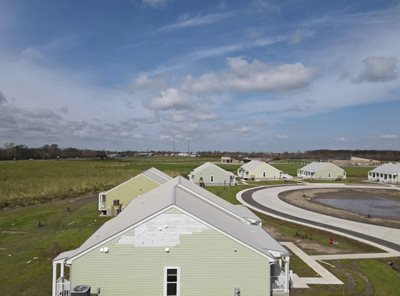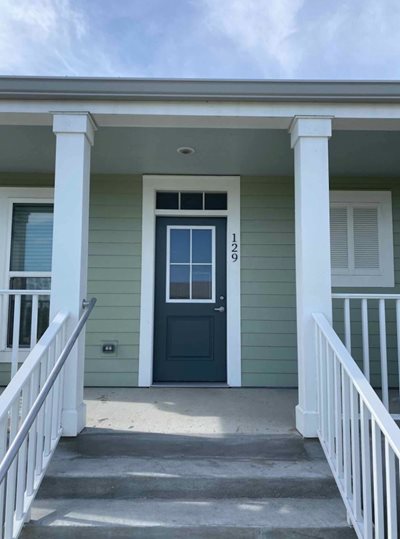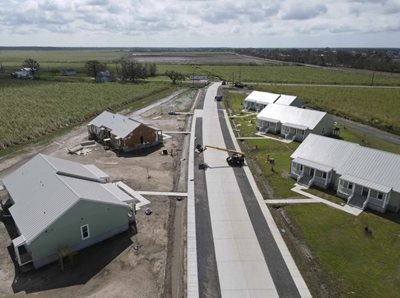In Louisiana, wind and rain from hurricanes and tropical storms had taken their toll. As state leaders searched for solutions, they chose a NeighborWorks network organization to help find them.
 "The state wants to create strategies and projects that protect against coastal land loss and increasing flood risk," says Kathy Laborde, president and CEO of Gulf Coast Housing Partnership (GCHP) a new NeighborWorks network affiliate based in New Orleans. With projects in states along the Gulf Coast they are acutely aware of the damage hurricanes cause to property – and lives.
"The state wants to create strategies and projects that protect against coastal land loss and increasing flood risk," says Kathy Laborde, president and CEO of Gulf Coast Housing Partnership (GCHP) a new NeighborWorks network affiliate based in New Orleans. With projects in states along the Gulf Coast they are acutely aware of the damage hurricanes cause to property – and lives.
When the Louisiana Office of Community Development and Louisiana Housing Corporation received Community Development Block Grants (CDBG) and National Disaster Resilience (NDR) grants to develop a project in Lafourche Parish in Louisiana, GCHP applied and won the chance to build a resilient neighborhood in Lockport. They selected the resilient features to incorporate and began to build. The idea was to build before a storm, rather than rebuild after one, explains Project Manager Will Bowling.
Adds Laborde, "It's important for people to understand that this is an issue facing us throughout the region. All of our state leaders are focused on what's happening on the coast." That focus centers around keeping people safe and out of harm's way. It also includes financial logistics, curtailing unsustainable insurance premiums. Without the added features and standards on this project, known as Les Maisons de Bayou Lafourche, they wouldn't have been able to get insurance, she says. As it was, only two insurers offered coverage. GCPH finished the project at the end of August, just as Hurricane Ida, second only to Hurricane Katrina in damage in Louisiana, hit the region. The project stood strong.
region. All of our state leaders are focused on what's happening on the coast." That focus centers around keeping people safe and out of harm's way. It also includes financial logistics, curtailing unsustainable insurance premiums. Without the added features and standards on this project, known as Les Maisons de Bayou Lafourche, they wouldn't have been able to get insurance, she says. As it was, only two insurers offered coverage. GCPH finished the project at the end of August, just as Hurricane Ida, second only to Hurricane Katrina in damage in Louisiana, hit the region. The project stood strong.
When you look at the new community, which includes 35 duplexes and triplexes, a playground and a community center, you won't see telephone poles or electrical lines. "That's because those are likely to be destroyed in a storm," says Bowling. "We did underground electrical and telecom."
Buildings are oriented North and South, positioned for maximum solar efficiency. There are water detention areas, to keep the sewage system from becoming overloaded, and buildings are elevated an extra three feet.
GCHP worked toward both a green standard and a Fortified Commercial Gold Rating. That meant reinforcing areas such as the windows, doors and roofs to make sure they aren't vulnerable to winds. "What it really means is that when Hurricane Ida passed over the project, we only lost some siding," Bowling says.
 The building has a switch panel so that GCHP can hook in a generator to power lights, refrigerators and more. Floors are tiled for easy mopping. Walls are made of paperless drywall, a fiberglass product that reduces the chance of mold. Along with extra insulation, there are dehumidifiers, "so it's like Colorado in there," even in August, Bowling adds.
The building has a switch panel so that GCHP can hook in a generator to power lights, refrigerators and more. Floors are tiled for easy mopping. Walls are made of paperless drywall, a fiberglass product that reduces the chance of mold. Along with extra insulation, there are dehumidifiers, "so it's like Colorado in there," even in August, Bowling adds.
As storms in Lockport become "old news," the region doesn't see much national media attention, Laborde says. "But people here are really suffering."
When Hurricane Ida hit Lafourche Parish, Constance Henderson was living in a mobile home in Raceland, Louisiana. She evacuated for the storm and returned to total devastation. Her home was flipped on its side. Thankfully, she had already applied to live in Les Maisons de Bayou Lafourche. She loves the new development, she says. "I feel safe here. My grandkids can come over and ride their bikes and play on the playground. They couldn't do that before."
Les Maison de Bayou Lafourche demonstrates the value that building in a resilient fashion can have for both long-term and short-term recovery from disasters, says Pat Forbes, executive director for Louisiana's Office of Community Development. "The development survived a devastating hurricane," he says. "It was exactly what we hoped for and expected."
Driving through the area impacted by Hurricane Ida shows the visible impact of previous construction decisions, governed by codes made more stringent following hurricanes Katrina and Rita. "It makes all the difference in the world when you can have fewer people displaced, fewer houses damaged," Forbes says. "It means more resources for our overall recovery. Projects like this give us an opportunity to see the values and benefits of building back smarter. We'll continue to do that, and build that into our recovery programs and our mitigation programs."
"In a way, this is a laboratory," Laborde says. "We understand the cost of these features and can study them and look at our pipeline ventures." The may have some tough choices. "But when you want maximum affordability that will withstand the test of time, you have to decide where the most value is, what will add the most resiliency for our citizens."
A drone video, taken after the storm, shows an overview of the properties, which sustained only minimal damage.
12/21/2021

